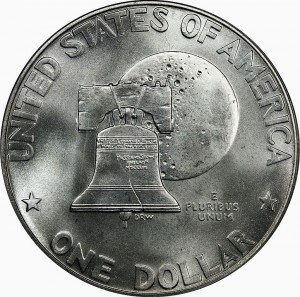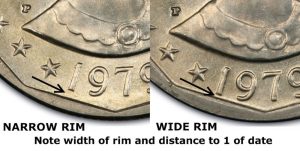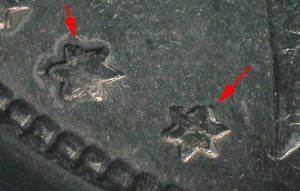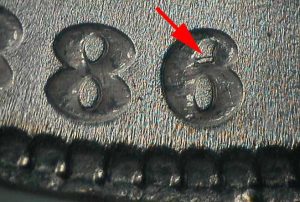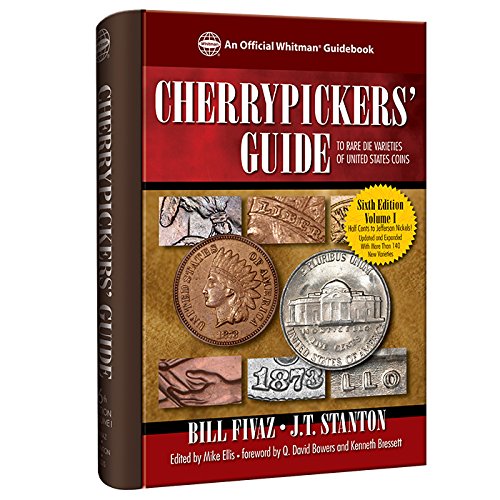- Errors versus Varieties: About Errors
- Errors verus Varieties: Varieties are spice ← you are here
A variety is a coin that differs from its basic design type in some distinctive way and is thus differentiated by collectors. Varieties are not errors. They are deliberate changes to the design whether it is to better define the design, adjust the design to strike better, or to add or change elements like dates and mintmarks.
A key difference between a variety and an error is that varieties are replicated for multiple strikes. Die changes, repunched mintmarks, repunched dates and over polishing of dies can reproduce the variety for the life of the die or until it is detected by Mint workers.
Nearly every series of coins has its own traceable die varieties that have been studied and catalogued by researchers. Researchers assign the varieties a number that is used by the third-party grading services to provide attribution to the variety on their holder.
- Bicentennial Dollar Type 1 (1975) Reverse
- Bicentennial Dollar Type 2 (1976) Reverse
- 1979 Susan B Anthony Varieties
Variety collecting is a very specialized subject. If you are going to collect varieties, you should read the references to understand the characteristics of the varieties. Some of the more well recognized and documented varieties include:
| Catalog | Coin Series | Main or Initial Reference |
|---|---|---|
| Cohen (C#) | Half Cents (1793-1857) | American Half Cents – The “Little Half Sisters” by Roger S. Cohen, Jr. |
| Sheldon (S#) | Large Cents (1793-1814) | Penny Whimsy by Dr. William H. Sheldon |
| Fortin (F#) | Liberty Seated Dimes (1837-1891) | Liberty Seated Dimes – Die Varieties, 1837 – 1891, by Gerry Fortin |
| Overton (O#) | Half Dollars (1794-1836) | Early half dollar die varieties, 1794-1836, by Al C. Overton and Donald L. Parsley |
| Van Allen-Mallis (VAM#) | Morgan and Peace Dollars (1878-1935) | Comprehensive Catalog and Encyclopedia of Morgan & Peace Dollars, by Leroy Van Allen and A. George Mallis |
| Fivaz-Stanton (FS#) | Varieties from the Cherrypickers’ Guide | Cherrypickers’ Guide to Rare Die Varieties of United States Coins, by Bill Fivaz and J.T. Stanton |
Arguably, the most collected series by varieties are Morgan Dollars. VAM varieties and catalog numbers were introduced to the hobby by Leroy Van Allen and A. George Mallis who discovered the varieties while examining Morgan and Peace Dollars. Their book, Comprehensive Catalog and Encyclopedia of Morgan & Peace Dollars began a hunt that has seen hundreds of more varieties found and cataloged.
Most VAM varieties cannot be seen without magnification and detailed knowledge of what to look for. The primary resource for VAM collectors is the VAMworld website. Aside from listing the identified VAM varieties, there are instructions how to identify VAM varieties.
- 1878-P VAM-169 Quadrupled Stars (courtesy of VAMworld)
- 1886-P VAM-1A Line in 6, Slightly Doubled Ear (Image courtesy of VAMworld)
- 1921-S VAM-6A Doubled Stars & Motto & Upper Reverse, Die Scratch (Image courtesy of VAMworld)
The third-party grading services have an optional service that will identify VAM varieties on their holders. However, they do not recognize all VAM varieties. There are three sub-lists of catalogued VAM varieties that are recognized. These varieties are as follows:
- TOP 100: The 100 most significant VAM Varieties known
- HOT 50: A list of additional 50 VAM Varieties that collectors are interested in finding. Many of these varieties are scarce and have sold for significant premiums
- HIT LIST 40: A list of 40 new VAM Varieties that have been discovered since the publishing of the HOT 50 list
General searching for varieties and errors should consider picking up a copy of Cherrypickers’ Guide to Rare Die Varieties of United States Coins by Bill Fivaz and J.T. Stanton. The book comes in two volumes. Volume 1 covers die varieties of half cents through nickel five-cent pieces. Volume 2 covers everything else including gold and bullion issues.
